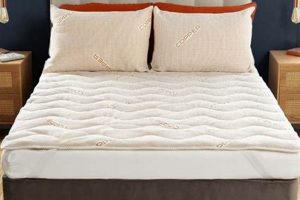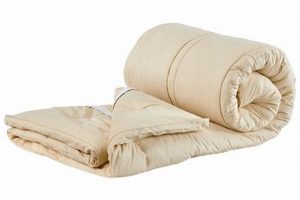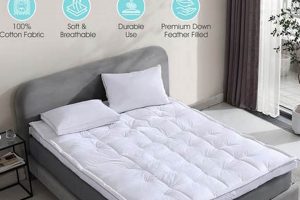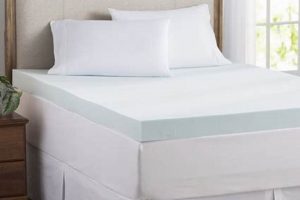A specialized cushioning layer designed to improve sleep comfort in the uniquely shaped sleeping areas found on many boats. These marine bedding accessories are crafted to fit the pointed configuration of a forward cabin’s sleeping platform, often found in sailboats and smaller powerboats. They typically consist of materials like memory foam, latex, or other synthetic fills designed to provide support and pressure relief. For instance, a vessel with a narrow front cabin may require custom-cut bedding to maximize usable sleeping space.
Installing a properly fitted layer provides enhanced comfort for those sleeping in the bow of the vessel. The addition of such a layer can mitigate discomfort caused by the often-thin factory-installed mattresses. Moreover, selecting materials with moisture-wicking properties is beneficial in the marine environment, where humidity and condensation are common. Historically, sailors often relied on rudimentary bedding, but modern advancements allow for improved rest and recuperation at sea.
The following sections will delve into the factors to consider when selecting a suitable solution, including material options, thickness considerations, customization possibilities, and maintenance recommendations. Understanding these aspects allows for a more informed decision, leading to increased comfort and improved sleep quality onboard.
Essential Considerations for V Berth Comfort
Optimizing sleep quality within the confines of a boat’s forward cabin requires careful selection and implementation. The following guidelines offer valuable insights for improving comfort in this unique sleeping environment.
Tip 1: Prioritize Material Quality: Opt for materials specifically designed for marine environments. Closed-cell foam, latex, or synthetic blends offer superior moisture resistance compared to traditional memory foam, mitigating mold and mildew growth.
Tip 2: Accurate Measurement is Crucial: The uniquely angled shape of a boat’s sleeping platform necessitates precise measurements. Templates may be required to ensure a snug, gap-free fit, maximizing usable sleeping surface and preventing slippage.
Tip 3: Consider Thickness Carefully: Balance comfort with available headroom. Thicker options offer greater cushioning, but may impede movement within the confined space. Assess the existing mattress’s support before selecting an add-on layer.
Tip 4: Explore Customization Options: Pre-made solutions may not perfectly conform to all boats. Custom fabrication provides an opportunity to address specific irregularities and ensure optimal coverage.
Tip 5: Evaluate Density for Support: Higher density materials provide firmer support, which can be beneficial for individuals with back pain. Conversely, lower density options offer a softer, more plush feel.
Tip 6: Invest in Breathable Covers: Fabric covers play a critical role in moisture management. Look for breathable, washable materials that promote air circulation and prevent heat buildup.
Tip 7: Anti-Slip Underlayment is Recommended: To prevent shifting during navigation, consider using an anti-slip underlayment. This adds an additional layer of stability, ensuring undisturbed sleep, particularly in rough seas.
Implementing these strategies can dramatically enhance the sleeping experience on board, promoting restful nights and improved overall well-being.
The subsequent section will provide guidance on maintaining the selected configuration, ensuring longevity and continued comfort.
1. Customized Shape
The requirement for specialized shaping constitutes a core aspect of bedding solutions for the uniquely configured sleeping quarters found in many vessels. The term accurately describes the tailoring needed to conform to the often-angled and non-rectangular geometry of these spaces, directly impacting comfort and usability.
- Precise Dimensional Conformance
The primary role of customized shaping involves exact adaptation to the specific measurements of the sleeping platform. Deviations from these dimensions result in gaps, overhangs, or compression, diminishing comfort and usable space. For example, a vessel with a sharply angled bow will necessitate a precisely cut piece to avoid bunching or sliding.
- Mitigation of Unusable Space
Incorrectly shaped bedding can lead to significant reductions in the effective sleeping area. Irregularities in shape, particularly in the corners or along the edges, can render portions of the platform unusable. This issue is particularly acute in smaller vessels where every inch of space is critical.
- Optimized Support Distribution
A customized shape ensures even distribution of support across the entire sleeping surface. Gaps or compression points caused by ill-fitting bedding can lead to uneven weight distribution, creating pressure points and discomfort. This is especially pertinent in the context of orthopedic support and pressure relief.
- Enhanced Aesthetic Integration
Beyond functionality, a well-executed shape contributes to the overall aesthetic of the cabin. Bedding that conforms precisely to the contours of the sleeping platform presents a more refined and visually appealing appearance, enhancing the sense of comfort and quality within the confined space.
These interconnected facets underscore the vital role of customized shaping in maximizing the comfort and functionality of sleeping arrangements. Addressing these considerations ensures a restful and supportive sleeping environment, ultimately contributing to a more enjoyable experience on board.
2. Moisture Resistance
The marine environment presents inherent challenges related to humidity, condensation, and the potential for water intrusion. These conditions directly impact the longevity and hygiene of bedding components, particularly within the confined spaces of a boat’s forward cabin. Consequently, moisture resistance is a critical attribute when selecting solutions designed for this location. Failure to prioritize this characteristic can lead to the development of mold, mildew, and unpleasant odors, compromising the sleeping environment and potentially affecting health.
Materials such as closed-cell foam, marine-grade latex, and specialized synthetic blends exhibit superior resistance to moisture absorption compared to traditional open-cell foam or natural fibers. Closed-cell structures inherently prevent water from penetrating the material’s core, mitigating the risk of microbial growth. For example, a topper constructed from closed-cell polyethylene foam can withstand exposure to damp conditions without significant degradation, while an open-cell foam counterpart may quickly become saturated and harbor mold. Similarly, specialized fabrics designed for mar
ine upholstery can repel water and promote ventilation, further reducing the risk of moisture accumulation within the bedding system.
In summary, the selection of moisture-resistant materials represents a fundamental consideration for maintaining a healthy and comfortable sleeping environment on board. Addressing this challenge through informed material choices can significantly extend the lifespan of the topper and prevent the development of unsanitary conditions. By prioritizing moisture resistance, boat owners can mitigate the negative effects of the marine environment and ensure a more restful and hygienic experience within the forward cabin. The choice enhances overall comfort and prevents potential health issues.
3. Supportive Density
Density, in the context of a v berth mattress topper, relates directly to the material’s ability to provide adequate spinal alignment and pressure relief. Higher density materials, such as high-density memory foam or latex, offer greater resistance to compression, preventing excessive sinking and maintaining a more consistent sleeping surface. This is particularly critical in the often-confined and irregularly shaped space of a boat’s forward cabin, where limited movement and restricted sleeping positions can exacerbate pressure points. For example, a sailor experiencing back pain might benefit significantly from a high-density foam topper, as it will minimize spinal curvature and reduce muscle strain throughout the night. Conversely, a low-density foam may compress too readily, failing to provide sufficient support and potentially worsening existing discomfort.
The selection of an appropriate density necessitates a careful consideration of individual sleeping preferences, body weight, and pre-existing medical conditions. Individuals who prefer a firmer sleeping surface or those with higher body weights typically require higher density materials to prevent bottoming out and maintain adequate support. Furthermore, the density of the topper should complement the existing mattress on the boat. Pairing a high-density topper with a very soft mattress might result in an unstable and uncomfortable sleeping arrangement. In contrast, combining it with a firmer mattress could produce an ideal balance of comfort and support. The practical implication is that selecting the wrong density can negate the benefits of investing in a topper altogether, leading to continued discomfort and disrupted sleep.
In summary, supportive density is a crucial determinant of the effectiveness of a v berth mattress topper. Its correct selection directly impacts spinal alignment, pressure relief, and overall sleeping comfort. Challenges arise in accurately assessing density needs without direct experience, emphasizing the value of seeking expert advice or trialing various options before committing to a purchase. Ultimately, prioritizing supportive density ensures that the topper fulfills its intended purpose of enhancing sleep quality within the unique constraints of a boat’s sleeping area.
4. Breathable Cover
The functionality of a v berth mattress topper is significantly influenced by the properties of its outer cover, particularly its breathability. A non-breathable cover inhibits air circulation, leading to moisture accumulation and elevated sleeping temperatures. The confined space of a boat cabin exacerbates this issue. Consequentially, a topper with a non-breathable cover may become uncomfortably warm and damp, disrupting sleep and promoting the growth of mold or mildew within the topper itself. For example, a vinyl or plastic cover, while waterproof, lacks breathability and can create a humid microclimate, negating the comfort benefits of the underlying foam. A practical outcome is restless sleep and premature degradation of the topper.
Breathable covers, typically constructed from natural fibers like cotton or linen, or synthetic blends engineered for moisture-wicking, facilitate airflow and allow moisture vapor to escape. This helps regulate sleeping temperature and maintain a dry surface. The benefits extend beyond mere comfort. The reduced moisture content inhibits microbial growth, prolonging the lifespan of the topper and maintaining a more hygienic sleeping environment. For instance, a topper with a bamboo-derived rayon cover offers excellent breathability and moisture absorption, creating a cooler and drier sleep surface compared to one with a standard polyester cover. The result is improved sleep quality and prolonged material integrity.
In conclusion, the breathability of the cover is not a mere aesthetic detail but an integral functional component of a v berth mattress topper. Its impact on moisture management, temperature regulation, and overall sleeping comfort is substantial. Prioritizing breathable materials for the cover ensures that the topper performs optimally, providing a comfortable, hygienic, and durable sleeping solution within the challenging environment of a boat’s forward cabin. The understanding is critical for informed decision-making and long-term satisfaction.
5. Secure Fit
The term “secure fit,” when applied to a v berth mattress topper, denotes the degree to which the item remains stably positioned atop the underlying mattress during typical use. This stability is essential for both comfort and safety within the confined and often-dynamic environment of a boat’s cabin.
- Prevention of Slippage During Navigation
A primary function of a secure fit is to prevent the topper from shifting or sliding during the boat’s movement, particularly in rough sea conditions. Unsecured bedding can create an unstable sleeping surface, increasing the risk of falls or discomfort. For example, a topper that slides off the mattress during a sharp turn can expose the sleeper to the hard surface beneath, disrupting sleep and potentially causing injury. Marine environments demand stable sleeping arrangements.
- Maintenance of Consistent Support
A secure fit ensures that the topper provides uniform support across the entire sleeping surface. If the topper shifts or bunches, it can create uneven pressure points, leading to discomfort and potentially exacerbating existing back or joint pain. Consider a situation where the topper gradually migrates towards one side of the berth, leaving a significant portion of the sleeper without adequate cushioning. Consistent support is essential for restful sleep.
- Preservation of Usable Sleeping Space
In the limited confines of a boat cabin, maintaining a full and usable sleeping area is critical. A topper that does not stay in place can encroach upon the available space, making it difficult to move around or get in and out of bed. This is particularly relevant in v berths, where the angled shape already presents spatial challenges. A poorly fitted topper reduces the effective size of the bed.
- Minimization of Material Degradation
A secure fit reduces friction between the topper and the underlying mattress or the surrounding cabin surfaces. Constant rubbing and movement can accelerate wear and tear on the topper’s fabric cover and internal materials, shortening its lifespan. A securely positioned topper is less susce
ptible to this type of damage.
These facets of “secure fit” are inextricably linked to the overall performance and longevity of a v berth mattress topper. A topper that addresses these considerations provides enhanced comfort, improved safety, and extended product lifespan, ultimately contributing to a more positive experience on board. The features reinforce functional requirements.
Frequently Asked Questions
The following addresses common inquiries regarding specialized bedding intended to enhance comfort in the forward sleeping quarters of watercraft.
Question 1: What materials are most suitable for a v berth mattress topper in a marine environment?
Closed-cell foam, marine-grade latex, and synthetic blends engineered for moisture resistance are optimal. These materials minimize water absorption, inhibiting mold and mildew growth common in humid conditions.
Question 2: How should one accurately measure the dimensions of a v berth for a custom-fit mattress topper?
Utilizing a flexible measuring tape to trace the perimeter of the sleeping platform is recommended. Consider creating a physical template using cardboard or paper to ensure accurate replication of the angled shape.
Question 3: What thickness of v berth mattress topper is generally recommended for optimal comfort?
Thickness selection depends on individual preference and available headroom. A range of 2 to 4 inches typically provides a balance of cushioning and maneuverability within the confined space.
Question 4: How does density affect the performance of a v berth mattress topper?
Higher density materials offer greater support and resistance to compression, making them suitable for individuals requiring enhanced spinal alignment. Lower density options provide a softer, more plush feel.
Question 5: What type of cover is recommended for a v berth mattress topper to ensure breathability and moisture management?
Covers made from natural fibers like cotton or linen, or synthetic blends designed for moisture-wicking, promote airflow and prevent moisture accumulation. Breathable covers reduce the risk of mold and mildew.
Question 6: How can the movement of a v berth mattress topper during navigation be minimized?
Employing an anti-slip underlayment beneath the topper or utilizing straps to secure it to the underlying mattress can prevent shifting during boat movement, particularly in rough seas.
Optimal selection and maintenance of a v berth mattress topper contribute significantly to sleep quality and overall comfort onboard. Addressing these factors allows for a more restful and enjoyable maritime experience.
The subsequent section will delve into maintenance and cleaning procedures to ensure the topper’s longevity.
Conclusion
The preceding analysis elucidates critical facets of the item. Understanding material properties, dimensional considerations, support requirements, and maintenance protocols proves essential for maximizing the benefits of this specialized bedding component. Optimizing these factors contributes directly to enhanced sleeping conditions within the constrained environment of a boat’s forward cabin.
The proper selection and upkeep of a v berth mattress topper represents an investment in onboard comfort and well-being. Prioritizing durable, moisture-resistant materials and ensuring a secure fit fosters a more restful and hygienic sleeping environment. Continued attention to these details ensures the longevity of the product and contributes to a more enjoyable maritime experience. Future research might explore advanced materials and innovative designs tailored to the unique challenges of marine bedding solutions.


![Best Half Queen Mattress Topper: [Benefits] & Sleep Better! Organic & Natural Mattress Buyer’s Guide: Non-Toxic Sleep Solutions Best Half Queen Mattress Topper: [Benefits] & Sleep Better! | Organic & Natural Mattress Buyer’s Guide: Non-Toxic Sleep Solutions](https://mattressworldpa.com/wp-content/uploads/2025/07/th-5936-300x200.jpg)




